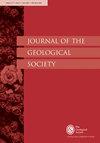新喀里多尼亚蛇绿混杂岩(西南太平洋)弧前侵入岩的新地球化学和年龄约束(40 Ar/39 Ar 和 U-Pb):热俯冲起始处产生的熔体的多样性
IF 3
3区 地球科学
Q2 GEOSCIENCES, MULTIDISCIPLINARY
引用次数: 0
摘要
新喀里多尼亚蛇绿岩被侵入于55.5Ma至50Ma(U-Pb锆石和40Ar/39Ar角闪石)之间的粗粒至中粒辉石和角闪石辉长岩/闪长岩岩体所横切,而更细粒的透辉石辉长岩则更年轻(50-47Ma)。角闪石-辉长岩/闪长岩的生成是通过变质独岩中的高温闪长岩的中等程度(20-40%)部分熔融来模拟的。最终成分组成--角闪岩和阳起石,是由构造活跃的岩浆导管内的晶体淤泥固相分离产生的。板块熔体与地幔楔橄榄岩的级联反应相继形成了霞石-白云母岩浆,这些岩浆在地幔-地壳转换过程中形成了榴辉岩透镜体,而霞石-白云母熔体又与橄榄岩反应形成了网纹岩。最年轻的托勒密岩浆出现在俯冲开始后的大约6Ma,当时较冷的俯冲板块陡然下降。最初的板块后退允许了角流,引发了隆起原生层的低压水合熔融。弧前岩浆活动的早期阶段与横贯剪切带密切相关,这些剪切带记录了斜俯冲的开始。新喀里多尼亚蛇绿岩的下始新世构造和岩浆特征见证了西南太平洋存在一个北倾或东北倾的热(强迫)俯冲带,它与稍年轻的西倾伊豆-波宁-马里亚纳冷(自发)俯冲系统明显不同。 专题集:本文是蛇绿岩、熔岩和蓝晶岩文集的一部分,可在以下网址查阅: https://www.lyellcollection.org/topic/collections/ophiolites-melanges-and-blueschists 补充材料: https://doi.org/10.6084/m9.figshare.c.6949265本文章由计算机程序翻译,如有差异,请以英文原文为准。
New geochemical and age constraints (
40
Ar/
39
Ar and U-Pb) on forearc intrusive rocks from New Caledonia Ophiolite (SW Pacific): diversity of melts generated at hot subduction inception
New Caledonia Ophiolite is crosscut by coarse to medium grained pyroxenites and hornblende gabbros/diorites dykes intruded between 55.5Ma and 50Ma (U-Pb zircon and
40
Ar/
39
Ar hornblende), while finer-grained dolerites of tholeiitic affinity are younger (50-47 Ma). Production of hornblende-gabbros/diorites was modelled by moderate degree (20-40%) of partial melting of the HT amphibolites of the metamorphic sole. End-member compositions, hornblendites and anorthosites, resulted from solid-state phase segregation of crystal mushes within tectonically active magmatic conduits. Cascade reactions of slab melts with mantle wedge peridotites successively formed clinoenstatite-boninite magmas, which fed gabbronorite cumulate lenses at the mantle-crust transition, in turn clinoenstatite-boninite melts reacted with peridotites to form websterites. The youngest magmas of tholeiitic affinity, appeared about 6 Ma after subduction inception when the cooler subducting slab plunged more steeply. Incipient slab retreat allowed corner flow, triggering low pressure hydrous melting of the uplifted asthenosphere . The early stages of forearc magmatism were closely associated with transcurrent shear zones, which recorded oblique subduction inception. The lower Eocene tectonic and magmatic features of the New Caledonia ophiolite witness the existence of a north- or northeast-dipping hot (forced) subduction zone in the Southwest Pacific, which appears notably distinct from the slightly younger west-dipping Izu-Bonin-Marianna cold (spontaneous) subduction system.
Thematic collection:
This article is part of the Ophiolites, melanges and blueschists collection available at:
https://www.lyellcollection.org/topic/collections/ophiolites-melanges-and-blueschists
Supplementary material:
https://doi.org/10.6084/m9.figshare.c.6949265
求助全文
通过发布文献求助,成功后即可免费获取论文全文。
去求助
来源期刊

Journal of the Geological Society
地学-地球科学综合
CiteScore
6.00
自引率
3.70%
发文量
68
审稿时长
6-12 weeks
期刊介绍:
Journal of the Geological Society (JGS) is owned and published by the Geological Society of London.
JGS publishes topical, high-quality recent research across the full range of Earth Sciences. Papers are interdisciplinary in nature and emphasize the development of an understanding of fundamental geological processes. Broad interest articles that refer to regional studies, but which extend beyond their geographical context are also welcomed.
Each year JGS presents the ‘JGS Early Career Award'' for papers published in the journal, which rewards the writing of well-written, exciting papers from early career geologists.
The journal publishes research and invited review articles, discussion papers and thematic sets.
 求助内容:
求助内容: 应助结果提醒方式:
应助结果提醒方式:


